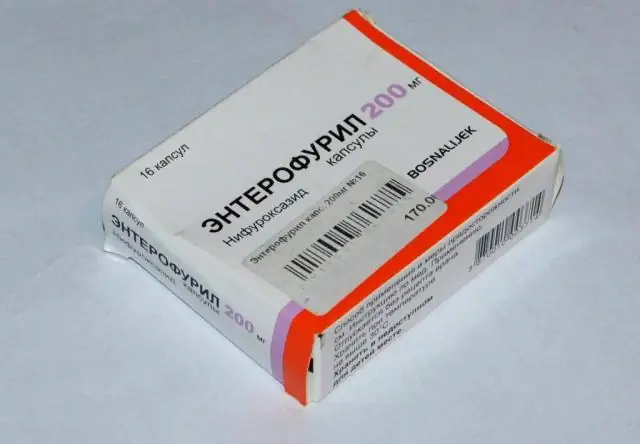Choludexan
Choludexan: instructions for use and reviews
- 1. Release form and composition
- 2. Pharmacological properties
- 3. Indications for use
- 4. Contraindications
- 5. Method of application and dosage
- 6. Side effects
- 7. Overdose
- 8. Special instructions
- 9. Application during pregnancy and lactation
- 10. Use in childhood
- 11. In case of impaired renal function
- 12. For violations of liver function
- 13. Drug interactions
- 14. Analogs
- 15. Terms and conditions of storage
- 16. Terms of dispensing from pharmacies
- 17. Reviews
- 18. Price in pharmacies
Latin name: Choludexan
ATX code: A05AA
Active ingredient: Ursodeoxycholic acid (Ursodeoxycholic acid)
Producer: SIGMA PHARMACEUTICAL INDUSTRIES (Egypt)
Description and photo update: 2018-23-10

Choludexan is a hepatoprotective drug.
Release form and composition
Choludexan is available in the form of size 0 gelatin capsules, with a pink body and a red cap, containing an almost white or white granular powder. Packing: blisters - 10 pcs., 2 or 6 blisters are packed in a cardboard box.
Composition of 1 capsule:
- active substance: ursodeoxycholic acid (UDCA) - 300 mg;
- additional components: colloidal silicon dioxide (aerosil 200), corn starch, magnesium stearate, granulated corn starch, potassium sorbate;
- capsule shell: gelatin, titanium dioxide, azorubin dye; additionally for the cap - crimson dye (Ponso 4R).
Pharmacological properties
Pharmacodynamics
Ursodeoxycholic acid is a hepatoprotective agent that also has cholelitholytic, choleretic, some immunomodulatory, hypocholesterolemic and hypolipidemic effects.
UDCA has high polar properties, due to which it forms non-toxic mixed micelles with apolar (toxic) bile acids. As a result, the ability of gastric refluctate to damage cell membranes is reduced. This effect is seen in patients with biliary reflux gastritis and reflux esophagitis.
In addition, the drug forms double molecules that can be incorporated into cell membranes (epithelial cells of the gastrointestinal tract, cholangiocytes, hepatocytes), stabilize them and make them immune to the effects of cytotoxic micelles.
UDCA reduces the concentration of bile acids that are toxic to liver cells and stimulates bicarbonate-rich choleresis. These properties of Choludexan contribute to the resolution of intrahepatic cholestasis.
The drug inhibits the absorption of cholesterol in the intestine, suppresses its synthesis in the liver and lowers the secretion in bile, thereby reducing the saturation of bile with this substance. In addition, it forms liquid crystals with cholesterol, thereby increasing its solubility. Reduces the lithogenic index of bile. Due to these properties of Choludexan, cholesterol stones dissolve, the formation of new stones is prevented.
The immunostimulating effect of ursodeoxycholic acid is due, inter alia, to its ability to inhibit the expression of HLA-1 antigens on the membranes of hepatocytes and HLA-2 on cholangiocytes, as well as to normalize the natural killer activity of lymphocytes.
It has been established that UDCA inhibits the progression of fibrosis in patients with alcoholic steatohepatitis, cystic fibrosis and primary biliary cirrhosis, and also reduces the risk of esophageal varicose veins.
Also, the drug slows down the processes of premature aging of cells and their death, including cholangiocytes and hepatocytes.
Pharmacokinetics
After oral administration, ursodeoxycholic acid is absorbed in the small intestine and ileum.
The maximum plasma concentration is observed after 1-3 hours.
When taking a dose of 50 mg, the plasma concentration after 30, 60 and 90 minutes reaches 3.8, respectively; 5.5 and 3.7 mmol / L.
The drug is characterized by a high bond with plasma proteins - up to 99%. Penetrates the placental barrier. With regular intake, UDCA becomes the main bile acid in the blood serum - about 48% of the total amount of bile acids present in the blood.
The therapeutic effectiveness of Choludexan depends on the concentration of ursodeoxycholic acid in bile.
The agent is metabolized in the liver (during the initial passage) with the formation of taurine and glycine conjugates, which are secreted into bile.
It is excreted mainly with bile - 50–70% of the total dose. A small amount of UDCA, which was not absorbed, enters the large intestine and undergoes 7-dehydroxylation (breakdown by bacteria). The formed lithocholic acid is partially absorbed in the large intestine, but most of it enters the liver, where it is sulfated and then rapidly excreted in the form of a sulfolitocholyltauric or sulfolitocholylglycine conjugate.
Indications for use
- toxic liver damage, including medicinal;
- primary sclerosing cholangitis;
- non-alcoholic steatohepatitis;
- alcoholic liver disease;
- dyskinesia of the biliary tract;
- primary biliary cirrhosis;
- congenital atresia of the bile duct;
- atresia of the intrahepatic biliary tract;
- chronic active hepatitis;
- biliary reflux gastritis and reflux esophagitis;
- cystic fibrosis;
- uncomplicated cholelithiasis (prevention of recurrence of stone formation after cholecystectomy, dissolution of cholesterol gallstones in the gallbladder if it is impossible to remove them by endoscopic / surgical method; biliary sludge).
Contraindications
- bile-gastric fistula;
- obturation of the biliary tract;
- high calcium gallstones (X-ray positive);
- acute infectious diseases of the intestines, bile ducts or gallbladder;
- acute cholecystitis;
- non-functioning gallbladder;
- empyema of the gallbladder;
- acute cholangitis;
- severe hepatic and / or renal failure;
- liver cirrhosis in the stage of decompensation;
- children under 3 years old;
- hypersensitivity to the drug.
Choludexan should be used with caution in children 3-4 years of age (they may have difficulty swallowing capsules).
Instructions for the use of Choludexan: method and dosage
The capsules should be taken by mouth and swallowed whole with sufficient drinking water. In case of diffuse liver diseases, administration is indicated 2-3 times a day with food, with biliary reflux gastritis and reflux esophagitis - 1 time a day, before bedtime.
Schemes for the use of Choludexan according to indications:
- toxic liver damage (including drugs), alcoholic liver disease, atresia of the intrahepatic biliary tract: 10-15 mg / kg per day for a course of 6 to 12 months, if necessary, longer treatment is possible;
- primary biliary cirrhosis: 10-15 mg / kg per day, the duration of therapy is from 6 months to several years. If necessary, it is possible to increase the daily dose to 20 mg / kg;
- primary sclerosing cholangitis: 12-15 mg / kg per day, duration of therapy - from 6 months to several years. If necessary, it is possible to increase the daily dose to 20 mg / kg;
- non-alcoholic steatohepatitis: 13-15 mg / kg per day, duration of therapy - from 6 months to several years;
- chronic liver diseases, cholesterol gallstones, biliary sludge: 10-15 mg / kg per day for a long time (up to several years). It is necessary to take the drug for cholesterol gallstones until they are completely dissolved and for another 3 months to prevent recurrence of stone formation;
- cystic fibrosis: 20-30 mg / kg per day, duration of therapy - from 6 months to several years;
- biliary reflux gastritis and reflux esophagitis: 300 mg once a day, before bedtime, the duration of treatment is from 10 days to 6 months. The course is extended to 2 years, if required;
- prevention of recurrence of cholelithiasis in patients after cholecystectomy: 300 mg 2 times a day for several months.
For children, Choludexan is prescribed in a daily dose of 10–20 mg / kg.
Side effects
During therapy with ursodeoxycholic acid, the following side effects may occur: diarrhea (usually dose-dependent), constipation, nausea, vomiting, back pain, increased activity of hepatic transaminases; rarely - alopecia, exacerbation of previously existing psoriasis, calcification of gallstones; with individual intolerance to the drug - allergic reactions.
Overdose
Overdose cases are unknown.
special instructions
To dissolve gallstones, Choludexan can be used if the following conditions are met:
- stones must be cholesterol (X-ray negative);
- the size of stones should be no more than 15–20 mm;
- the filling of stones in the gallbladder should not be more than half;
- the gallbladder must be functional;
- the patency of the common bile and cystic ducts must be preserved.
After the stones have completely dissolved for another 3 months, it is recommended to continue taking the drug to prevent relapse and dissolve the remains of stones that are too small to detect them.
With long-term use of Choludexan, a biochemical blood test should be performed to determine the activity of hepatic transaminases: the first 3 months of treatment - every 4 weeks, then - 1 time in 3 months.
The effectiveness of therapy is monitored every 6 months using X-ray and ultrasound examinations of the biliary tract.
If after 6 months at least partial dissolution of the stones has not occurred, further treatment is likely to be ineffective.
Influence on the ability to drive vehicles and complex mechanisms
According to the instructions, Choludexan does not have a negative effect on the speed of reactions and concentration.
Application during pregnancy and lactation
During pregnancy, Choludexan can be used only in exceptional cases, if the intended benefits of therapy for the mother outweigh the possible risks to the fetus, since strictly controlled adequate studies of the use of UDCA during pregnancy in humans have not been conducted.
There are no data on the release of UDCA in breast milk, therefore, the advisability of stopping breastfeeding for the period of therapy should be considered.
Women of childbearing age are advised to use reliable non-hormonal methods of contraception during treatment.
Pediatric use
- children under 3 years of age: the use of the drug is contraindicated;
- children 3-4 years: treatment should be carried out with caution.
With impaired renal function
Severe renal failure is a contraindication to the appointment of Choludexan.
For violations of liver function
Severe hepatic failure is a contraindication to the appointment of Choludexan.
Drug interactions
Choludexan enhances the effect of oral hypoglycemic drugs.
The absorption of UDCA is reduced by antacid aluminum-containing agents and ion-exchange resins (for example, cholestyramine).
Progestins, estrogens, lipid-lowering drugs (especially clofibrate) and neomycin contribute to the increase in the saturation of bile with cholesterol, as a result of which they can reduce the effect of ursodeoxycholic acid on the ability to dissolve cholesterol bile stones.
Analogs
Choludexan analogs are: Ursodez, Grinterol, Ursodeoxycholic acid, Ursomik, Livodexa, Ekshol, Ursoliv, Ursofalk, Ursorom S, Ekurohol, Urdoksa, Ursosan, Ursoprim.
Terms and conditions of storage
Store no more than 3 years out of the reach of children at a temperature of 15-25 ° C.
Terms of dispensing from pharmacies
Dispensed by prescription.
Reviews about Choludexan
Reviews of Choludexan from patients who used it according to indications are mostly positive: the drug is effective for biliary dyskinesia, gastritis, liver diseases, cholelithiasis and practically does not cause side effects.
The disadvantages of the drug include its relatively high price and the need to take for a long time.
The price of Choludexan in pharmacies
The price for Choludexan is 560-600 rubles per pack of 20 capsules.

Anna Kozlova Medical journalist About the author
Education: Rostov State Medical University, specialty "General Medicine".
Information about the drug is generalized, provided for informational purposes only and does not replace the official instructions. Self-medication is hazardous to health!







